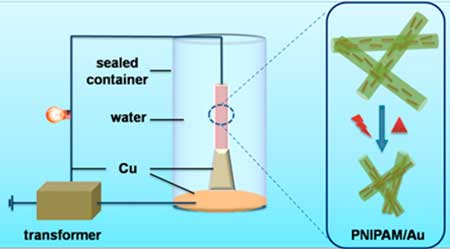| Posted: Jul 17, 2017 | |
Stimuli-responsive hydrogel for smart switch(Nanowerk News) Researchers in China report the preparation of a gold nanorod/thermoresponsive polymer composite hydrogel that shows fast thermal/photo response, high stability, high heating rate, and high structural integrity by a traditional electrospinning technique (ACS Applied Materials & Interfaces, "Highly Stimuli-Responsive Au Nanorods/Poly(N-isopropylacrylamide) (PNIPAM) Composite Hydrogel for Smart Switch"). |
|
| Both the porous structure of the hydrogel and the assemble effect of gold nanorods (AuNRs) within the PNIPAM (poly(N-isopropylacrylamide)) fibers facilitate fast thermal and photoresponse, and high structural integrity even in acidic or basic condition. | |
 |
|
| Scheme of AuNRs/PNIPAM-Based Thermal/Photocontrolled Switch. (© ACS) | |
| Besides the porous structure, AuNRs inside the hydrogel fibers were assembled and aligned along the long axial direction of the fibers. | |
| The synergistic effect of polymers and colloidal nanoparticles assures new classes of composite materials and have been intensively investigated due to their unique properties and fascinating applications in many areas. | |
| The polymer component plays a key role in modulating the properties of the inorganic nanoparticles relating to the optical, catalytic, electrical, sensing, and biomedical fields. | |
| These composite materials present a higher degree of chemical or physical complexity than the isolated components. | |
| The most significant challenge for thermoresponsive hydrogels is to achieve both fast response and structural integrity during the repeating volume changes. The researchers addresses this issue by using fibrous materials prepared by electrospinning that possess high specific area and large porosity. The porous structures in the hydrogel is conductive to water pathways, which can greatly promote the response rate. | |
| The team notes that, simply by steaming gold on the surfaces, this cross-linked composite hydrogel can be used as one novel kind of thermal/photocontrolled switch. | |
| The prepared AuNRs/PNIPAM composite hydrogel also has high valuable potential applications in a 'smart' sensor, nanoreactor, catalysis, and artificial muscle. In addition, other nanoparticles, such as magnetic nanoparticles or quantum dots, also could be incorporated with PNIPAM by this facile method to produce novel stimuli-responsive functional materials. |
 By
Michael
Berger
– Michael is author of three books by the Royal Society of Chemistry:
Nano-Society: Pushing the Boundaries of Technology,
Nanotechnology: The Future is Tiny, and
Nanoengineering: The Skills and Tools Making Technology Invisible
Copyright ©
Nanowerk LLC
By
Michael
Berger
– Michael is author of three books by the Royal Society of Chemistry:
Nano-Society: Pushing the Boundaries of Technology,
Nanotechnology: The Future is Tiny, and
Nanoengineering: The Skills and Tools Making Technology Invisible
Copyright ©
Nanowerk LLC
|
|
|
Subscribe to a free copy of one of our daily Nanowerk Newsletter Email Digests with a compilation of all of the day's news. |
